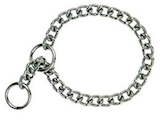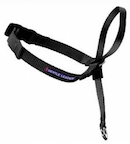
Finding the Best Harness for Dogs that Pull
With all the harnesses and collars on the market today, it can be hard to know which ones will both work and be safe, especially the best harness for dogs that pull. Every product seems to claim it can stop the pulling — but without buying everything in the pet store and trying it out yourself, how are you to know which product will work best? Choosing the best harness for dogs that pull, which stops pulling on a leash without causing discomfort or long-term damage, can be difficult.
Why Basic Collars Are Bad for Dogs That Pull
The most common product I see on dogs is the standard flat collar. This collar typically has a buckle and one or two rings to attach the dog’s identification and licenses.
When you are walking a dog that loves to pull, this is probably one of the worst collars you can use:
- Allows the dog to drag you all over
- Constant pressure can lead to a collapsed trachea
- Does not prevent pulling effectively
Using the best harness for dogs that pull can help avoid these issues and ensure a safer, more comfortable walk for your pet.
Why Choke and Slip Collars Are Bad for Dogs That Pull

Along with the flat collar, the choke or slip collar will also cause problems. I do not recommend these collars for the general dog owner because they can cause serious harm to dogs without an experienced trainer guiding them.
- Can cause serious harm by choking the dog
- Teach dogs to behave through fear, not positive training methods
- Require expert handling to avoid injury
Using the best dog collars for pulling is a safer and more effective choice for reducing pulling behavior.
Why Prong Collars Should Be Left to Experts

Although the prong collar looks scary, it is actually more humane than the choke collar.
- Limited constriction ability, designed to pinch the dog’s skin
- Self-correcting effect when fitted properly
- Best used with an experienced trainer to avoid causing pain
I do not suggest these collars to the general dog owner. They can cause immense pain if fitted improperly and used incorrectly. Experts have concluded that sudden or continuous pressure upon a dog’s neck can cause serious, sometimes permanent damage to the spine, neck, and trachea. My best suggestion is to keep the pressure off the dog’s neck.
Head Collars: The Best Solution for Pulling Dogs

One of my favorite dog collars to stop pulling on a leash is the head collar.
- Consists of two straps: one around the muzzle and one around the dog’s head
- Allows you to lead the dog without yanking on the neck
- Applies pressure to the muzzle to trigger relaxation when the dog pulls
- Not a muzzle; the dog can pant, eat, drink, and bark normally
Training Tips:
- Let your dog wear the head collar without the leash for about two weeks.
- Gradually apply pressure to the nose strap and offer treats.
- Attach the leash and practice walking slowly.
Popular brands of head collars include Halti, Control Ease, and Gentle Leader.
Using the best harness for dogs that pull, like the head collar, ensures safe and effective training.
Benefits of Front Clip Harnesses for Dogs That Pull
Another one of my favorite products is the front clip harness. It allows you to attach your leash between the breastbone of the dog.
- Front Clip Harness vs. Step-in Harness: Step-in harnesses encourage pulling, as they mimic sled dog harnesses. In contrast, the front clip harness applies pressure to the front of the dog, discouraging pulling.
- Suitable for All Ages: Front clip harnesses can be used on any age dog and are more easily accepted by dogs than head collars.
- Popular Brands: PetSafe Easy Walk and SENSE-ation No-Pull Harness are two good brands.
Using the best harness for dogs that pull, which decreases pulling without interfering with your dog’s health, ensures a more enjoyable walking experience for both you and your dog.
By incorporating the best harness for dogs that pull, like the front clip harness, you can improve your dog’s walking behavior safely and effectively.
Choosing the best harness for dogs that pull, which stops pulling on a leash without causing discomfort or long-term damage, can be difficult. Additionally, ensuring the right fit is crucial for your dog’s safety and comfort. For more details on this, check out our article on How Tight Should a Dog Collar Be?
How to Properly Fit a Harness for Dogs That Pull
Properly fitting a harness is crucial to ensure it works effectively and comfortably for your dog.
- Measure Your Dog:
- Measure the girth (widest part of the chest) and the neck circumference.
- Refer to the manufacturer’s sizing chart.
- Adjust the Straps:
- Adjust all straps for a snug but not tight fit.
- Ensure you can fit two fingers between the harness and your dog’s body.
- Check for Comfort:
- Ensure the harness doesn’t rub or chafe.
- Observe your dog’s movements to ensure there’s no restriction.
Training Tips with the Best Harness for Dogs That Pull
Training your dog to walk properly with a harness involves patience and consistency.
- Introduce the Harness Gradually:
- Let your dog wear the harness indoors without the leash.
- Reward your dog with treats and praise.
- Start Indoors:
- Attach the leash and practice walking indoors before moving outside.
- Use treats to encourage walking beside you.
- Use Positive Reinforcement:
- Reward your dog for walking calmly without pulling.
- Stop walking if your dog pulls, and resume when they stop pulling.
Maintenance and Care for Your Dog’s Harness
Regular maintenance ensures the harness remains effective and comfortable.
- Cleaning:
- Hand wash or machine wash as per the manufacturer’s instructions.
- Use mild detergent and air dry.
- Inspection:
- Regularly check for wear and tear.
- Replace the harness if you notice fraying or weakened parts.
- Storage:
- Store the harness in a dry place.
- Avoid leaving it in direct sunlight for prolonged periods.
Conclusion: Ensuring the Best Experience for You and Your Dog
Finding the best harness for dogs that pull is essential for a comfortable and safe walking experience. Here’s a summary of the key points to consider:
- Proper Fit:
- Measure your dog correctly.
- Adjust straps for a snug fit.
- Ensure comfort without chafing.
- Effective Training:
- Introduce the harness gradually.
- Start training indoors.
- Use positive reinforcement consistently.
- Regular Maintenance:
- Clean the harness as per instructions.
- Inspect regularly for wear and tear.
- Store properly to prolong lifespan.
By following these tips and choosing the best harness for dogs that pull, you can enjoy more peaceful and enjoyable walks with your furry friend.
Frequently Asked Questions (FAQ)
What harness is best for dogs that pull?
The best harness for dogs that pull is typically a front clip harness, like the PetSafe Easy Walk.
What is the best dog harness?
When looking for the best dog harness, consider options that discourage pulling and ensure comfort, such as the SENSE-ation No-Pull Harness.
Best harness for dogs that pull when walking?
For dogs that pull when walking, the best harness options are those with a front clip design to effectively reduce pulling behavior.
References
- “Best Harnesses for Dogs That Pull.” Forbes. https://www.forbes.com/sites/forbes-personal-shopper/article/best-harnesses-for-dogs-that-pull/
- “Best Dog Harness.” Wirecutter, The New York Times. https://www.nytimes.com/wirecutter/reviews/best-dog-harness/


